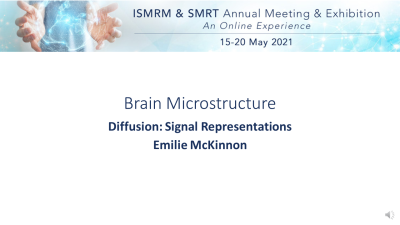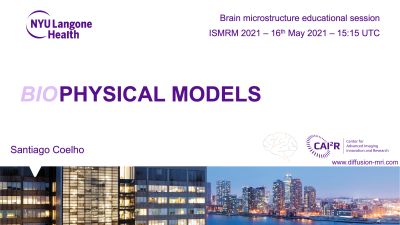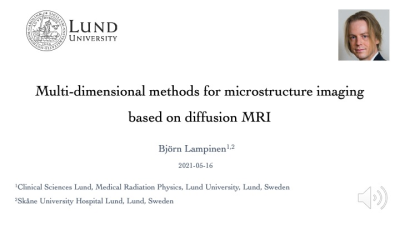Weekend Course
Brain Microstructure
ISMRM & SMRT Annual Meeting • 15-20 May 2021

| Concurrent 2 | 15:15 - 16:00 | Moderators: Mark Does & Derek Jones |
 |
Diffusion: Signal Representations
Emilie McKinnon
A typical diffusion experiment exists of images acquired at different gradient directions and diffusion weightings. These large datasets necessitate transformation into compact metrics which facilitate comparisons between subjects, brain regions, or experimental settings. This conversion requires the fitting of mathematical functions called signal representations. Signal representations can be motivated by general diffusion physics, microstructural models, or simply by mathematical functions with convenient properties. Depending on the type of signal representation, the fitting parameters can have true physical meaning (e.g., diffusivity), biological meaning (e.g., axon diameter), or they can be a pure mathematical construct (e.g. spherical harmonic coefficients).
|
|
 |
Diffusion: Spectroscopy
Chloé Najac
Diffusion-weighted magnetic resonance spectroscopy (DW-MRS) offers a unique opportunity to probe tissue microstructure in vivo. Here we discuss the motivations behind DW-MRS and the specificity of brain metabolites vs. water molecules. Some of the conventional sequences used in DW-MRS experiments are described. A "live" DW-MRS acquisition on a clinical MRI scanner is shown as well as some of the essential steps for processing DW-MRS data. We give some examples of the unique features that can be extracted, such as the length of neuronal and glial processes or the microscopic anisotropy of neurons and glial cells. Finally, take-home messages are summarized.
|
|
 |
Diffusion: Physical Models
Santiago Coelho
This talk examines current diffusion MRI modeling approaches for brain tissue. Biophysical models and signal representations are contrasted. How diffusion coarse-graining facilitates modeling is explained. Emphasis is put on the identification of common modeling assumptions and examples on how to validate them. High diffusion weighting and long and short diffusion times are discussed together with state-of-the-art biophysical modeling techniques on each. Finally, future directions for modeling brain tissue are discussed.
|
|
 |
Susceptibility
Richard Bowtell
Microstructural variation in magnetic susceptibility can have significant effects on signal magnitude and phase in GE images. The effect of microstructure on R2* and local frequency depends on the susceptibility, volume fraction, shape, orientation and ‘spin density’ of structures. Myelin and non-haeme iron have largest effects in brain tissue. Measured R2*and susceptibility are strongly correlated with macroscopic iron content and show some sensitivity to microstructure. WM tracts appear diamagnetic, with elevated R2* when perpendicular to B0. This behaviour is explained by the anisotropic susceptibility of lipid chains in the myelin which introduces complex dependence of GE signal on WM microstructure.
|
|
| Brain Microstructure: Relaxation
Eva Alonso Ortiz
The most commonly used MRI sequences, T1-weighted, T2-weighted, and T2*-weighted are used to generate images whose contrast depends on T1, T2, and T2* relaxation values. However, the images themselves are not direct measures of T1, T2, and T2* which are physical characteristics of the tissues. T1-weighted, T2-weighted, and T2*-weighted images are used to identify areas of abnormally bright or dark signals, but they do not tell us anything specific about changes in tissue. In this presentation you will learn how relaxation arises, how it can be measured, and what it can tell us about the brain’s microstructure.
|
||
| Magnetization Transfer
Olivier Girard
This lecture will cover the basic principles of magnetization transfer (MT) imaging techniques targeted toward immobile macromolecules in brain and describe how these techniques may inform on the local tissue microstructure. Following this lecture, the attendees should 1/ understand the origin of the magnetization transfer signal within heterogeneous systems such as brain tissues, 2/ understand simplified biophysical modelling aiming at describing myelinated white matter in the context of MT imaging; and 3/ understand how the orientation of the myelinated axons may affect MT measurements and how this may influence other contrasts (T1, T2) measured in the brain.
|
||
 |
Multi-dimensional methods for microstructure imaging based on diffusion MRI
Björn Lampinen
Microstructure imaging aims to infer brain tissue quantities using diffusion MRI. However, conventional diffusion MRI yields only a few observables with limited specificity. Multi-dimensional methods use additional acquisition dimensions to obtain new observables with higher specificity. Data acquired using multiple b-tensor shapes separate the effects of structural shape and variation in size. Data acquired using multiple echo times may separate the densities and T2 properties of tissue components. Microstructure modeling aims to increase specificity by interpreting the available data through a tissue model. Although modeling may complement multi-dimensional acquisitions, the approach stresses rather than replaces the need for independent data.
|
|
| Critical Review
Matthew Budde
This talk will provide an overview of considerations and challenges to bringing Microstructure Imaging techniques to the clinical setting and issues concerning validation of methods to improve specificity and understanding of the MRI-pathology relationships.
|
The International Society for Magnetic Resonance in Medicine is accredited by the Accreditation Council for Continuing Medical Education to provide continuing medical education for physicians.